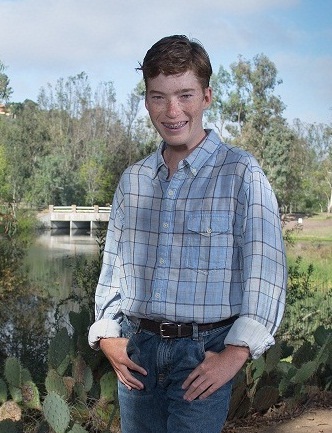Groundbreaking scoliosis treatment takes boy to mountain top

Finn is standing tall after innovative scoliosis surgery.
By Jeanne Bellezzo
When 14-year-old Finn McCool climbed Mt. Whitney in a single day last summer, it was quite an accomplishment — and not just because of his age. Thanks to innovative spinal surgery, Finn hiked 22 miles up the mountain and back with his father and siblings. And the family is planning
their next climb.
“A couple of years ago, I would never have envisioned Finn being able to do this,” says Brian McCool, Finn’s dad.
At age 6, Finn was diagnosed with moderate scoliosis, or curvature of the spine. Peter Newton, M.D., chief of the division of orthopedics and scoliosis at Rady Children’s Hospital-San Diego and a clinical professor at UC San Diego, first recommended the conventional treatment, a chest brace, to see if it would slow down the 35-40 degree curvature in Finn’s spine as he grew. But after two years in the brace, the scoliosis continued to worsen.
Traditionally, the next step would have been surgery to fuse the vertebrae and stop the curvature from progressing. Finn’s family hoped for another option, as the fusion could potentially limit the spine’s growth and flexibility for the rest of Finn’s life.
“We were getting to the point where we needed to make a decision, and we asked Dr. Newton if there was anything else, any other alternative we could consider,” Brian says. “And he told us there was.”
Trying the tether
Dr. Newton proposed that Finn undergo a relatively new procedure called spinal tethering, for which he had conducted research in animal models more than a decade ago to test the safety and effectiveness. Tethering involves placing screws into the vertebrae through the chest along the rounded side of the curve and connecting a long piece of cord between the screws. Tension is then applied to the cord to correct the curvature.
“The goal is that as the patient grows, the tension in the cord will limit the growth on the curved side of the spine and allow the other side to grow,” Dr. Newton explains. “So over time the spine will grow straight.”
The McCools decided to try it. “By chance, Dr. Newton was one of a handful of surgeons in the U.S. trained in this procedure,” Brian says. “It was extremely fortuitous that the physician we’d already been seeing was the one who knew how to do this. The odds of that were mind-boggling to me.”
Finn was 10 years old when he had the surgery, which is performed under general anesthesia. The lung on the side where the screws are inserted is deflated during the procedure to allow the surgeon to operate on the chest without the lung in the way. Using a minimally invasive endoscopic technique, the surgeon makes just four incisions, each smaller than an inch, implants the screws and cord, and adjusts the tension. The procedure takes three to four hours.
Finn spent three days in hospital and was back in school less than two weeks later. He wore a brace for the first few months following surgery until the screws took hold in his spine.
Nearly four years later, the tethering has completely corrected his curve. The Cathedral Catholic High School freshman runs, swims and hikes with his family, including his mother, Meghan. Another mountain climb is also in Finn’s future; his father plans to tackle Mt. Kilimanjaro with the kids in the next few years.
Checking the curve
Now that Finn’s spine is straight, he may require another surgery to remove the tether so that it doesn’t overcorrect and start curving the other way.
“One of the real challenges of this technique is that it is relatively new, and we don’t yet have a full understanding of how much growth is required for a given deformity,” Dr. Newton notes, adding that good candidates for tethering are generally 9 to 12 years old and have 45-60 degree curves in the thoracic (mid-back) region. “The main concerns are incomplete correction or overcorrection. Predictability is much lower than with fusion techniques, so people who choose this have to understand that we don’t have it all figured out just yet.”
Brian is confident they made the right decision. “I’ve had parents with kids in the same boat call me, and I tell them what our experience was. Worst case, if the tethering didn’t work, you could always go back to the traditional fusion surgery,” he says. “For us, this procedure has been a modern miracle.”
Signs of scoliosis
Signs of scoliosis are usually noticeable in a child by the age of 10. Here’s what to watch for:
■ One shoulder, shoulder blade or hip is higher or more prominent than the other.
■ Your child’s head may not be exactly centered over his pelvis.
■ When your child is standing with arms hanging straight at sides, there may be more
space between his arm and body on one side.
■ When your child bends forward until the spine is horizontal, one side of his back may
appear higher than the other.
According to orthopedic surgeon Dr. Peter Newton, a brace is the first treatment for moderate curves and must be used while the child is still growing. “Surgery is used for severe curves that don’t respond to bracing or kids who present too late, after the growth spurt is complete,” he says.
Originally published in The San Diego Union-Tribune, October 2015